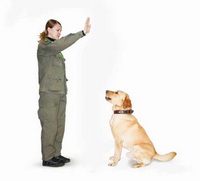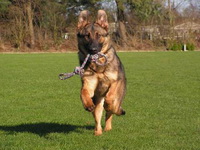Think doggy
 The attitude of the dog to its owner is one of the important, and often the dominant, aspect of the behavior of the animal. But why one dog obeys its owner, and the other – no? How to make an effective process of training? How to learn to understand your dog? And how to instill in him the necessary skills?
The attitude of the dog to its owner is one of the important, and often the dominant, aspect of the behavior of the animal. But why one dog obeys its owner, and the other – no? How to make an effective process of training? How to learn to understand your dog? And how to instill in him the necessary skills?
The answer is unusual, but at the same time simple. In order to achieve mutual understanding with your dog and achieve success in training, you just need to learn to think like a dog. Our wonderful dogs are deprived of a second signaling system, that is, speech, and therefore cannot tell us in words about their desires, sorrows, joys, pain, or longing. However, we still can try to understand them by looking at the world through the eyes of a dog.
Do not expect that at the age of one you will bring your pet to the training ground and he will immediately be taught to the mind. It is much more difficult to re-educate a maturing dog that is not accustomed to obeying, than teaching a child step by step. That is why I believe that the basics of education and initial training should be laid as soon as the puppy has learned in your home. As they grow up, the puppy accumulates life experience, which consists in the response reactions to this or that situation, and over time, repetitive forms of behavior turn into stereotypes. In this case, I note that the actions of the puppy are dictated primarily by his own “considerations”, and therefore often do not coincide with your desires and requirements. Remember: teaching a dog “from scratch” is always easier than retraining.
The process of training should be consistent and focused. Forbid your puppy from doing what you will not allow an adult dog. From childhood, he must learn a code of conduct in human housing and society. Be patient and persistent. Do not expect from a three-month puppy the same results as from a half-year old. At the age of 10 months, the dog may look quite adult, but one should not think that at the same time it will behave like a solid, mature animal. For most large breeds, the average age at maturity is 2 years. Great Danes, Mastiffs, Giant Schnauzers, Black Terriers and other giants of the dog world mature later, finally forming their exterior and psychological portrait only after three years of age.
Dogs are endowed with a primitive mind, but it does not resemble the human mind. In addition, they can not understand a word from what people say. That is why you can train your dog in any language of the peoples of the world or you can replace the generally accepted voice commands with any selected words or even abstract sounds. Thus, as a command to attack, trainers use a variety of words (“Fas!”, “Take!”, “Jackal!”, “Kill!”, “Tear!”) Or pronounced hissing hiss-whistling sounds. One of the reasons why traditional teams are replaced with code words is that no one but the owner can command this dog. This is especially important for working dogs that are used for protection in real conditions. By using non-standard words for commands, you can be sure that the attacker cannot verbally neutralize your dog.
In the process of training, dogs are trained to understand commands by combining frequently repeated words with the desired action. At the same time, animals have a certain “sixth” feeling, which helps to quickly understand the character, mood, and even the state of human health. In some ways this is akin to our intuition. Using this feeling in combination with a highly developed instinct and instinctive knowledge, dogs immediately assess the degree of human dominance, his emotional background and even the nature of the course of metabolism. For example, scientists have found that dogs can “predict” an attack of epilepsy, which has become widely used in special training. It is known that even a small puppy feels nervousness, insecurity or discontent of its owner. And such negative emotions are the surest way to make a dog fearful, unruly or unbalanced. That is why in education and daily communication with the dog, the main thing is positive attitude and patience. Remember, you are the creator, and your little pupil is a sponge that absorbs both good and negative.
However, do not give the dog the ability to distinguish between good and bad, right and wrong. These concepts are not in the world of animals, led by instincts and conditioned reflexes. Moral evaluation of actions is a purely human prerogative. The dog does not understand what to do a puddle on the carpet – this is bad; that clawing the front door is also bad; it is bad to rummage in a garbage can, it is bad to pick up stones on the street, to bark badly at a neighbor’s cat. Remember: you can explain to the dog the rules of behavior not by long, confusing notations, but by targeted training with the simulation of practical situations, moving from simple to complex. Remember also that the value of things and interior for your pet also does not mean anything.


